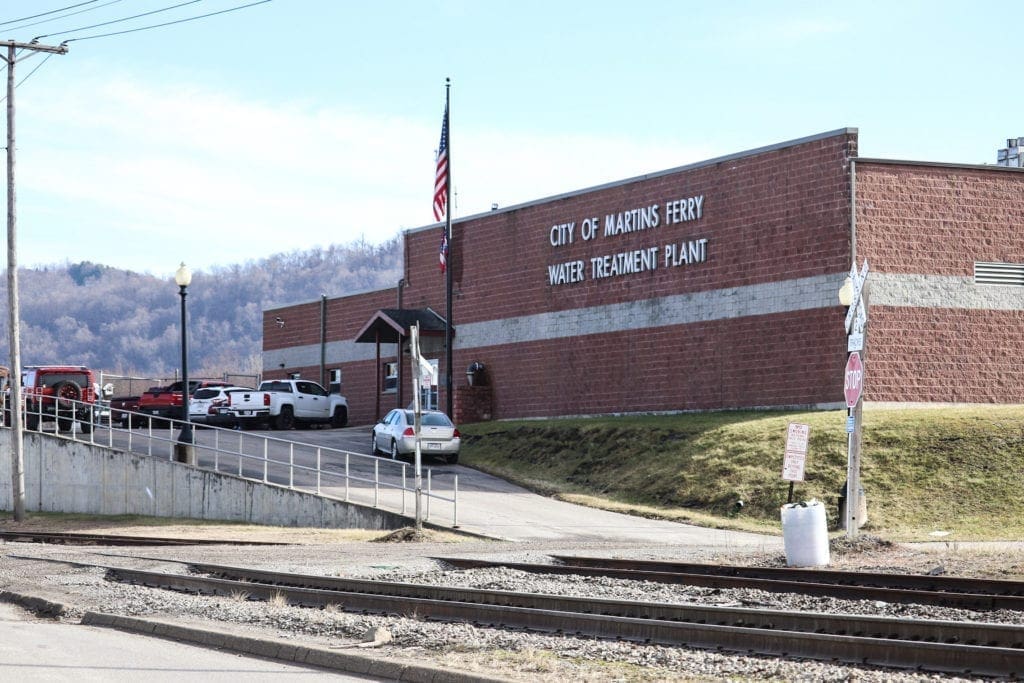Resolving the St. Clairsville water situation is going to result in increased water and sewer rates for city residents going forward.
That much is a certainty. Repairs are needed. Changes must be made. Neither is free. Increases are coming. The important questions of how much that increase will be, which entity will ultimately supply the water, and which will own the city’s water system are still up in the air.
Engineer Jeff Vaughn from Vaughn, Coast and Vaughn gave his detailed report to city council this week outlining the city’s options and giving estimated costs, both for repairs, and increases in water and sewer rates depending on what avenues were taken going forward.
Estimates are just that, estimates. They aren’t set in stone nor are they contractual. But they do help paint a picture and give council a better shot at making the best, and most cost-effective decision for its citizens.
“Jeff was charged with drafting a term paper at 2 a.m. that was due later that morning at 8 and he was able to do it,” St. Clairsville Mayor Kathryn Thalman lauded. “We can’t thank him enough. There are still variables. We don’t have it in writing that the county is going to charge us this much; we have estimations. That’s the best info we have at the moment.”
Vaughn talked at length about the city relying on purchasing bulk water from Belmont County and what that will require to bring it to fruition. He also discussed both as similar option with Martins Ferry to purchase bulk water, along with the original tabled purchase agreement made by Aqua Ohio with the city.
In terms of the Aqua Ohio portion, the ordinance previously voted on and tabled became null and void after it was revealed changes to it were now necessary following updated orders from the EPA.
According to Thalman, Aqua Ohio has agreed to step back from its May 4 deadline to approve the original agreement because of the changes. More details about that will be given during a 9:30 a.m. Thursday morning press conference at council chambers.
What’s Needed for County Viability?
Vaughan went into additional detail on what the city needs to do to be able to switch to purchasing its full allotment of water off Belmont County by the Ohio EPA’s deadline. Again, that deadline was hoped to be five years. It’s been whittled to two.
But first, backstory. In the 1960s, the city and county together installed two connections from the county’s water system to the city’s lines. The first was the East End connection, adjacent to U.S. 40 and Rehm Road. The West End connection is at the intersection of Willow Grove and Clark roads. Both were in service until 2005. That’s when the two entities combined on a joint project with Ohio Public Works Commission funding that allowed the county to pump directly to the city’s main transmission line through a booster at the water plant.
Flash forward to today. The booster at the plant can account for around 320,000 gallons per day; a sizeable amount but far short of the between 500-600k gallons needed by the city. Capacity isn’t an issue here. It’s hydraulics.
“The county water plant can pump around six million gallons per day,” Belmont County Commissioner J.P. Dutton said. “Currently, we’re doing around 3.2 million per day, so we could more than meet St. Clairsville’s needs. But right now, it’s an issue of hydraulics.”
That booster station is going to need, well, a boost, until the county’s Ohio 9 pumping station and the new water treatment plant slated to be built along the Ohio River in Bellaire near Muxie’s Distributing, comes online.
That means the East End booster will need reestablished to help offset what the current booster at the water plant lacks in pumping capacity.
Vaughn estimated that cost at around $518,000. The debt service on that upgrade Vaughn noted would be less than 70 centers per customer.
Once that’s done, he said the county can provide the full requirement of gallons for the city and, once the new plant and Ohio 9 booster are finished, then the East End booster can service as a backup and help with redundancy.

County Rates and Estimated Increases
Vaughn noted the county gave the figure of $4.36 per 1,000 gallons of bulk purchase price. Since the county system only supplies the bulk water, St. Clairsville would still be in charge of distribution, any repairs and wastewater treatment. The city, should it not sell to Aqua, would continue to set its own rates.
Vaughn noted that a current ordinance calls for $22.98 for city water as the base rate for 2,000 gallons of usage. That would go up to 24.98 in 2021 and 26.98 in 2022. From that point, with bulk water now being purchase from the county, rates would increase at a less steep rate, first at four percent, then three and on down to two.
He noted the average monthly consumption for city customers is 3,109 gallons. That amount of usage would see a bill rise of 34.57 in 2000 to $43 in 10 years with all the costs and debt service estimated in the increases.
The sewer side would see similar changes as the city’s wastewater treatment plant needs repairs. Once again, using the average usage rate of 3,109 gallons, sewer rates would climb from $25.54 in 2020 to $35.51 in the same timespan as the water.
Conversely, Vaughn estimated the Martins Ferry connection would have a greater up-front cost.
The Ferry water system currently has a 12-inch line out near Colerain that it could run down through Barton and connect with St. Clairsville’s lines somewhere on N. Sugar Street. Vaughn noted this will require roughly 6.5 miles of new water line run, along with a pump station. Martins Ferry Water Superintendent Bill Suto, however, noted in an earlier story on LedeNews that he found a shorter path that cut the amount of line needed to approximately five miles.
Vaughn assumed that the project would cost $6.2 million and, based on a 30-year zero interest loan secured by Martins Ferry as the operating entity, would cost St. C. customers around $7.20 monthly in debt service for the duration of the loan. Vaughn also noted he believed that the bulk price per gallon through Ferry was slightly higher than the county.
“It was worth it to go through the analysis as Ferry was doing it best to be good neighbors and was looking to sell some of its excess water,” Vaughn said. “We wanted to indicate what that would be in terms of real numbers. But it’s not economical because Belmont County is already connected and there is less cost.
The mayor agreed, though she didn’t rule out the city’s neighbors along the river as a secondary option.
“Right now, the most viable option is the county one because the connections are there,” Thalman said. “If somehow Ferry can get some funding and is able to pipe it into our system, that would give us two sources and we are open to that.”
Could Those County Costs Increase?
County water customers are still adjusting to the pangs of higher rates. In 2018, the minimum bill for water was $13 with a rate of $4.93 per 1,000 gallons. That jumped to $20 in 2019 for the minimum and $5.71 per 1,000 gallons.
That was done so the county could finally quality for the $72 million in loans and grants provided by the USDA Rural Development program, the largest such award in state history for the program. Prior to that, county customers enjoyed quoted low rates for a lengthy period of time.
But as problems persisted and debt was incurred with the county system, rates were never increased to match, so general fund money had to be allocated to cover the debt. Not a sustainable plan. No state or federal agency was angling to offer up any funding either.
“Our rates were so low for so long, we would ask for grants or loans and the state or federal agency would tell us they can’t justify giving us assistance when we aren’t charging the customers enough,” Dutton said. “We couldn’t qualify, so we had to raise them considerably Doing so allowed us to qualify for these two packages. It was a difficult decision, but at the end of the day it allowed us to secure 72 million dollars total in loans and grants.”
Sixty of that $72 million is a 2.3 percent interest loan that will go toward water projects throughout the county, including $20 million alone for the new water plant and a good portion for the Ohio 9 booster station. The remaining $12 million is a grant. An additional $12 million award was issued just prior for sewer upgrades, with $3 million of that total being in grant form.
Dutton said the county’s rates are tied to inflation and will be looked at periodically. He added the county had to get to a spot where the USDA felt comfortable making that 40-year commitment and that rates needed to increase and stay where necessary to honor that commitment.

Joining Forces?
As previously mentioned, the county can pump roughly 6 million gallons per day. Martins Ferry’s system has the capacity for 7.5 million with a few upgrades. The Purple City is only using and/or selling less than half of its pumping capacity.
Combined that’s quite a lot of gallons potentially available for sale to say, perhaps a planned for large-usage customer that may set up somewhere near Dilles Bottom. Or it could be used for any potential major investments that could be coming to the St. Clair Commons section of the county seat.
Dutton didn’t name specifics but did note the county has been in contact with Martins Ferry about water purchase.
“We’ve had preliminary conversations with Martins Ferry, both with the prior mayor and the new administration,” Dutton said. “We think long-term, there is a lot of value working with other water systems in Belmont County. Our first priority right now is focusing on the USDA package and getting those projects going. At the same time, if there is some way we could team up, that would be a good thing.”


